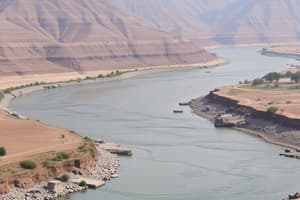Podcast
Questions and Answers
What distinguishes east flowing rivers from west flowing rivers in the Peninsular plateau?
What distinguishes east flowing rivers from west flowing rivers in the Peninsular plateau?
East flowing rivers generally drain into the Bay of Bengal, while west flowing rivers drain into the Arabian Sea.
Explain the economic significance of rivers in a country like India.
Explain the economic significance of rivers in a country like India.
Rivers are crucial for irrigation, drinking water supply, transportation, and hydroelectric power generation, thus supporting agriculture and industries.
Why is the Damodar River referred to as the 'Sorrow of Bengal'?
Why is the Damodar River referred to as the 'Sorrow of Bengal'?
It is referred to as such due to its frequent flooding, which causes significant damage to agriculture and property in West Bengal.
Identify the river known for the Nagarjuna Sagar project and its significance.
Identify the river known for the Nagarjuna Sagar project and its significance.
What is the longest river in India?
What is the longest river in India?
Which river originates from Beas Kund and is significant for irrigation in Northern India?
Which river originates from Beas Kund and is significant for irrigation in Northern India?
Name the river that rises in the Betul district of Madhya Pradesh and flows westward.
Name the river that rises in the Betul district of Madhya Pradesh and flows westward.
What role does the Narmada River play in the geography of Peninsular India?
What role does the Narmada River play in the geography of Peninsular India?
Which river is recognized for creating a delta where it meets the Bay of Bengal?
Which river is recognized for creating a delta where it meets the Bay of Bengal?
Identify a river of South India that receives rainfall in both monsoon seasons.
Identify a river of South India that receives rainfall in both monsoon seasons.
Flashcards are hidden until you start studying
Study Notes
Indus River System
- Major tributaries include the Zaskar, Nubra, Shyok Delta, and Hunza in the Kashmir region.
- The Indus flows through Baltistan and Gilgit, emerging at Attock.
- Tributaries such as Satluj, Beas, Ravi, Chenab, and Jhelum join near Mithankot, Pakistan.
- It has a total length of 2900 km, making it one of the longest rivers globally.
- Over one-third of the Indus basin is in India (Jammu and Kashmir, Himachal Pradesh, Punjab), while the rest is in Pakistan.
- Seasonal rivers in the Peninsula, like Chambal, Betwa, and Son, originate from semi-arid areas and have shorter courses.
Kaveri River
- The Kaveri rises in the Brahmagri range, flowing 760 km to the Bay of Bengal south of Cuddalore, Tamil Nadu.
- Main tributaries include Amravati, Bhavani, Hemavati, and Kabini.
- The river plays a crucial role in the regional hydrogeology and agricultural irrigation.
Lakes in India
- Lakes vary in size, origin, and permanence, with most being permanent.
- Many lakes are formed through glacial action, river processes, or human intervention, like damming.
- Significant natural lakes include Dal Lake in Kashmir and the man-made Guru Gobind Sagar from the Bhakra Nangal Project.
- Lakes enhance tourism, recreation, and ecological balance by regulating river flow.
Environmental Role of Lakes
- Lakes regulate river flow, preventing floods during heavy rains and maintaining flow in dry seasons.
- They are crucial for hydel power generation and support local ecosystems, tourism, and recreation.
River Conservation Efforts
- The National River Conservation Plan (NRCP) addresses the pollution of Indian rivers.
- The Ganga Action Plan Phase-I closed in 2000, affecting ongoing river conservation efforts across 27 interstate rivers.
- Pollution abatement works target 57 towns, with 215 schemes approved, and 69 completed thus far.
Economic Importance of Rivers
- Rivers have historically attracted settlements, which evolved into large cities.
- They provide essential water resources for agriculture, industry, and domestic use.
- Compare the eastern and western flowing rivers of the Peninsular plateau for insights into their economic relevance.
Map Skills and Activities
- Suggested tasks include marking rivers like the Ganga, Satluj, Krishna, and lakes such as Chilika and Wular on outline maps of India.
- Crossword puzzles offer an engaging way to learn about specific rivers and their characteristics.
Studying That Suits You
Use AI to generate personalized quizzes and flashcards to suit your learning preferences.




